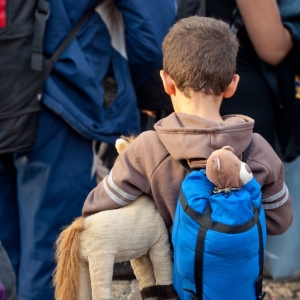Indicators in this domain assess the extent to which migrants have the same status as citizens in terms of access to basic social services such as health, education, and social security. It also describes the rights of migrants to family reunification, to work, and to residency and citizenship. The ratification of the main international conventions is also included within this domain.
Indicators in this category look at the extent to which migrants have access to certain social services such as health, education and social security. They also examine measures to ensure integration and access to work.
Indicators in this domain assess countries’ institutional, legal, and regulatory frameworks related to migration policies. Domain 2 also reviews the existence of national migration strategies that are in-line with development, as well as institutional transparency and coherence in relation to migration management. This domain also investigates the extent to which governments collect and use migration data.
Indicators in this category assess the institutional frameworks of cities for migration. This area also examines the existence of migration strategies consistent with development objectives, as well as institutional transparency and coherence in migration management.
This domain focuses on countries’ efforts to cooperate on migration-related issues with other states and with relevant non-governmental actors, including civil society organizations and the private sector. Cooperation can lead to improvements in governance by aligning and raising standards, increasing dialogue and providing structures to overcome challenges.
Indicators in this category focus on cities’ efforts to cooperate on migration issues with the national government as well as other cities and relevant non-governmental actors, including civil society organizations and the private sector.
This domain includes indicators on countries’ policies for managing the socioeconomic well-being of migrants, through aspects such as the recognition of migrants’ educational and professional qualifications, provisions regulating student migration and the existence of bilateral labour agreements between countries. Indicators equally focus on policies and strategies related to diaspora engagement and migrant remittances.
Indicators in this category assess cities’ initiatives in terms of international student mobility, access to the labour market and decent working conditions for migrant workers. Aspects related to diaspora engagement and migrant remittances are also included in this domain.
This domain studies the type and level of preparedness of countries when they are faced with mobility dimensions of crises, linked to either disasters, the environment and/or conflict. The questions are used to identify the processes in place for nationals and non-nationals both during and after disasters, including whether humanitarian assistance is equally available to migrants as it is to citizens.
Indicators in this category examine the type and level of readiness of cities to deal with aspects of mobility crises. The questions focus on the processes in place for citizens and non-citizens both during and after disasters, especially if humanitarian assistance is available for migrants and citizens.
This domain analyses countries’ approach to migration management in terms of border control and enforcement policies, admission criteria for migrants, preparedness and resilience in the case of significant and unexpected migration flows, as well as the fight against trafficking in human beings and smuggling of migrants. It also assesses efforts and incentives to help integrate returning citizens.
Indicators in this category look at the cities’ approaches to migrant safety as well as return and reintegration policies and the fight against trafficking in persons.
This country Profile describes examples of well-developed areas of the Republic of Nicaragua (hereafter referred to as Nicaragua) migration governance structures and areas with potential for further development, as evaluated through the six domains of the Migration Governance Indicators (MGI). These address migrants’ rights, a “whole-of-government” approach, partnerships, socioeconomic well-being of migrants, the mobility dimensions of crises, and safe and orderly migration.
Click the icons on the wheel to explore the key findings.
The Migration Governance Indicators (MGI) initiative is a policy-benchmarking programme led by the International Organization for Migration (IOM) and implemented with research and analysis from the Economist Impact. Funding is provided by IOM Member States.
Migration Governance: examples of well-developed areas
- All migrants have access to public-funded health.
- Primary and secondary education allow for migrants to enter the public and free educational system.
- The kin of permanent and temporary residents benefit from the same immigration status by consanguinity.
- Under the Anti–-Trafficking in Persons Law (2015), the rights of victims of trafficking include voluntary repatriation and family reunification in a safe environment.
Areas with potential for further development:
- Only certain categories of migrants have access to social protection on the same terms as nationals.
- Labour legislation does not incorporate specific provisions for the employment of migrants.
Migration Governance: examples of well-developed areas
- The National Human Development Plan (NHDP) covers migration and the legal and policy instruments on migration are aligned with the NHDP.
- The National Council for Migration and Foreigners is the government body responsible for designing and coordinating the implementation of migration policy.
- The Ministry of the Interior’s Directorate General for Migration and Foreigners (DGME) has the authority over migration control and services.
Areas with potential for further development:
- Despite the existence of consular representations abroad, there are no labour attachés or specialized offices outside Nicaragua.
Migration Governance: examples of well-developed areas
- Nicaragua participates in consultative process and regional forums such as the Central American Commission of Migration Directors (OCAM) and the Regional Conference on Migration (RCM).
- Nicaragua participates in the Regional Coalition against Human Trafficking and Migrant Smuggling.
- Nicaragua is a member of the Central American Integration System (SICA), a body in which regional actions are developed, including on migration issues.
Areas with potential for further development:
- The Government involves various stakeholders on an ad hoc basis in setting the agenda and implementing issues related to migration.
- There is scope for strengthening alliances by consolidating actions spearheaded by regional bodies such as CORETT, the RCM, OCAM and SICA, for dialogue and the production of reference material on vulnerable populations.
Migration Governance: examples of well-developed areas
- In 2020, the “Binational Agreement to Regulate the Temporary Hiring of Nicaraguan Workers in Costa Rica” was signed, in the context of COVID-19.
- The Government compiles labour market data disaggregated by immigration status and sex.
- The Central Bank of Nicaragua is responsible for monitoring and consolidating remittance statistics, using information provided by remittance service providers and commercial banks.
Areas with potential for further development:
- The country does not implement a national assessment of the demand for immigrants in the labour market.
- There are no formal programmes to promote financial inclusion or the formalization of remittance flows, although some commercial banks and remittance companies have such programmes.
Migration Governance: examples of well-developed areas
- Nicaragua has an emergency communication system to meet the needs of the general public, including migrants.
- The country has adopted measures allowing exceptions to immigration procedures for non-nationals whose country of origin is in crisis.
Areas with potential for further development:
- The National Response Plan for disaster prevention does not contain specific provisions addressing human mobility or forced displacement during disasters.
- The National Risk Management Plan does not address issues of migration or large-scale population movements.
Migration Governance: examples of well-developed areas
- The National Academy of Migration and Foreigners provides continuous training to migration personnel.
- The Anti–Trafficking in Persons Law (2015) includes measures to combat labour exploitation of migrants.
- The legal framework governing migration guarantees that migrants are detained only as a last resort.
- Nicaragua has systems in place to track and identify migrants, through the Ministry of the Interior’s consular services and the National Police.
Areas with potential for further development:
- It is not possible for visitors and migrants to complete the visa application procedure online prior to arrival in Nicaragua.
2021 August




